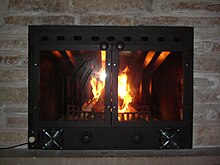
A fireplace insert is a device that can be inserted into an existing masonry or prefabricated wood fireplace. Fireplace inserts are invariably made from cast iron or steel. Typically, fresh air enters through vents below, circulates around the main chamber, where it is heated up, then exits through the chimney. They have insulated glass doors that allow the fire to be viewed while closed, improving fuel efficiency and heat output. Air is directed across the interior surface of the glass to prevent the buildup of ash.
Fireplace inserts are categorized primarily by the type of fuel used (natural gas, propane, EPA-certified wood, pellet, coal and electric).
History[edit]
The fireplace insert was invented in 1896 by Joab R. Donaldson of Oliphant Furnace, Pennsylvania, United States.[1] Joab was a 59-year-old coal miner and father of 14 at the time of his patent. He came upon the idea as a means of using coke (a smokeless fuel made by the destructive distillation of certain types of coal) and incorporating the use of an electric blower to improve the efficiency. The selection of coke and coal tailings as a primary fuel enabled low-income families to heat their Appalachian homes with small-size coal that they could easily dig for themselves in their own backyards.
Electric fireplace inserts[edit]
Electric fireplace inserts are made to fit any size of a brick or steel-covered hearth. Plug-in electric fireplace inserts typically connect to a common 120-volt wall plug and are placed within an existing fireplace.
Electric fireplace inserts come in three form factors:
- Electric log inserts (which imitate a natural wood flame)
- Plug-in inserts
- Built-in units

See also[edit]
References[edit]
- ^ Joab R. Donaldson (1896) "Fireplace" U.S. patent 000,561,871
Well, that’s interesting to know that Psilotum nudum are known as whisk ferns. Psilotum nudum is the commoner species of the two. While the P. flaccidum is a rare species and is found in the tropical islands. Both the species are usually epiphytic in habit and grow upon tree ferns. These species may also be terrestrial and grow in humus or in the crevices of the rocks.
View the detailed Guide of Psilotum nudum: Detailed Study Of Psilotum Nudum (Whisk Fern), Classification, Anatomy, Reproduction